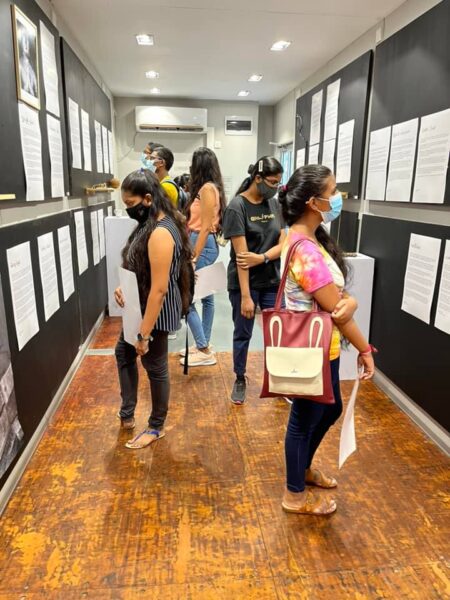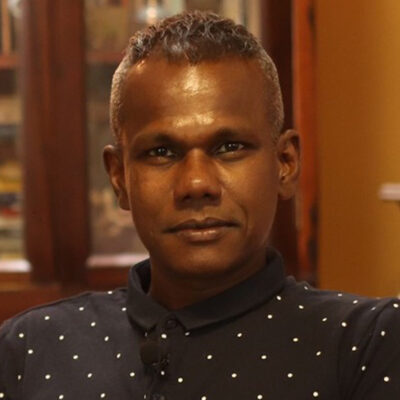
Sri Lanka’s ‘It’s About Time’ travelling history museum
Visakesa Chandrasekaram
“The ‘It’s About Time’ travelling history museum was designed as a platform for a collection of exhibits to explore concepts of history, narrative and its relationship to the present. The overall objective of the museum is to allow visitors ‘to critically reflect on history and find constructive ways of dealing with the past’.
The ‘It’s About Time’ travelling history museum reaches out to local communities by engaging with them through a range of interactive exhibitions and educational activities and events. This travelling history museum first began as a German Development Cooperation (GIZ) project under a broader program aiming to strengthen the post-war reconciliation process initiated by the Government of Sri Lanka. The main objective of the program was to provide an alternative platform to use different approaches to showcase history outside the conventional museum space and step out of the rather rigid existing framework of learning history.
Passing through Sri Lanka’s recent crisis points such as the Easter attack, pandemic lockdowns and foreign debt crisis which prompted mass protests, the travelling history museum has evolved without losing its original and defining characteristics.
Strategies include:
- Connecting with communities
Locals from each community are engaged at all levels of the visiting museum’s operations, from the consultations and the sourcing of exhibition materials to site set-up, volunteer staff and organising affiliated events. - Innovative curation
A reinterpretation of history is introduced through a unique combination of artifacts, interactive activities and localised events to provide a multi-sensory experience for visitors. Visitor perceptions of history are challenged and the real stories of individuals in displays encourage thought-provoking discussions. - Agile museum methodology
Museum displays, activities and events are continually reviewed based on visitor feedback and relevance to ensure optimal visitor experiences and best practices. The museum has evolved through local and global crises to go virtual without losing its capacity to physically travel to remote sites to connect with visitors around the nation.
Before, during and the after the 30-year-long civil war which ended in 2009, contrasting narratives on the origin and the existence of its people have been told, memorised and circulated within the boundaries of the different ethnic groups: Sinhala, Tamil, Muslim and Burgher. These contradictory narratives divided the nation, fuelling ethnic animosities and sourcing political ideologies to justify the war. This history is taught in schools as a body of rigid knowledge, not to be reinterpreted or questioned. The framers of the post-war reconciliation initiatives in Sri Lanka, therefore, unsurprisingly looked for opportunities to strengthen the reconciliation efforts by opening a dialogue on history. The travelling history museum was initiated by the ‘Strengthening Reconciliation Processes in Sri Lanka’ program co-funded by the German Federal Foreign Office and the European Union for the term of 2017 to 2022. The ‘It’s About Time’ travelling history museum was designed as a platform for a collection of exhibits to explore concepts of history, narrative and its relationship to the present. The overall objective of the museum is to allow visitors ‘to critically reflect on history and find constructive ways of dealing with the past’.
Connecting with communities
Museums in Sri Lanka are mainly located in the cities and in areas of archaeological significance and they function as premises which mostly exhibit ancient artifacts. The travelling history museum, on the other hand, took the museum outside the city centres to the peripheries, customising the museum exhibits and activities to suit the local communities and their available infrastructure. This flexible concept therefore allowed the museum to set up in large indoor congregation areas as well as in smaller spaces such as refurbished shipping containers. Rather than arbitrarily selecting a location and setting up the museum, the curators connected with the local communities through schools, local public officers and history or arts clubs, months ahead of the museum opening. Through this networking, some of the cultural safety matters were identified and locals were inclusively recruited to volunteer in the museum as guides or community representatives to run affiliated events such as film screenings, musical recitals, human library activities, memory walks or history discussions. Since its inception, approximately 18,000 people have visited the travelling history museum at various locations. The local communities at each location also collaborate with the curators to source local materials including artifacts and oral history to be exhibited in the museum.

Exhibits in a refurbished shipping container. Photo credit: It’s About Time.

Affiliated events at the travelling museum site. Photo credit: It’s About Time
Innovative curation
The museum experience was designed to challenge the existing rigid framework of learning and understanding history, to identify gaps in the suppressed parts of the history and to adopt a more critical approach to question the process of learning history. Visitor perceptions of history are challenged by the displays and activities which provoke direct or indirect questions; for example, asking whether history is an interpretation or fact and whether the history of an individual matters. The visitors are provided with clues to answer these questions; for example, through real personal items of unknown individuals with a story presenting each individual’s experiences behind those items. Simultaneously, the curators also challenge the dominant version of the nation’s history by presenting an alternative narrative with evidence; for example, displaying real stories and illustrations on exhibition boards and carefully avoiding the myths and legends which have been embedded in the official narrative of the nation’s history. Unlike conventional museums, the curators of the travelling history museum select items to provide a multi-sensory experience, such as listening to recorded voice tracks on local oral history, navigating history through touchscreen digital display panels, touching and feeling the surface of certain artifacts and tasting certain local dishes prepared by different methods adopted from regional culinary practices.

Schoolchildren receiving an interactive museum experience. Photo credit: It’s About Time.

Schoolchildren receiving an interactive museum experience. Photo credit: It’s About Time.
Agile museum methodology
The curators follow a flexible methodology to source and present materials in the museum to be able to constantly review and redesign the museum displays and activities as needed. In the early days of the museum’s operation, the curators faced some criticism from the visitors that the stories presented through the museum’s exhibitions were ‘sad’ and they wanted some positive stories too. Responding to this feedback, the curators went on to source happier stories of individual memories to balance out the tragic shared history of the war. This shift helped the curators to design a visitor experience to facilitate a process of self-reflection on one’s own history; for example, an installation was set up with the question ‘Who am I?’ next to a large mirror which a visitor would pass through, then write down their thoughts on their own individual history.
When the nation was hit by the pandemic, followed by the chronic fuel shortage due to the foreign debt crisis, much of the population became less mobile and the curators looked for new methods of operationalising the museum. In the meantime, mass protests were taking place to demand systemic change in governance, creating new interest in history, particularly among young people. Inspired by the youth participation in political activism, the curators have conceptualised a virtual museum to continue the dialogue with visitors to critically appreciate the nation’s history. Materials, including the stories collected and presented in the travelling history museum, have been digitally archived, with social media channels being used to continue the dialogue with virtual visitors of the museum.
Due to the museum’s enthusiastic reception and popularity, a unit that had started off as a project of a development cooperation five years ago has now registered locally as an independent and specialist institution called the Collective for Historical Dialogue and Memory (CHDM) to continue the important work.
Dr Visakesa Chandrasekaram
| Dr Visakesa Chandrasekaram is a lawyer, academic and an artist. He has made two feature films – ‘Sayapethi Kusuma’ (Frangipani) and ‘Paangshu’ (Earth) which won many international awards. He has published two novels – ‘Tigers Don’t Confess’ and ‘The King and the Assassin’. He has written and directed several stage plays including ‘Forbidden Area’, which won the Gratiean Prize. Visakesa has worked in Sri Lanka as a human rights lawyer and in Australia as a diversity consultant to the NSW Government. He currently works as a senior lecturer in the Faculty of Law in University of Colombo. |
What is the Imagine Around the World Project?
A partnership with the British Council Australia, the Imagine Around The World Project aims to document case studies from numerous countries outside of US, UK, Canada, Australia and New Zealand to share best practice and leadership in cultural diversity, cultural equity and inclusion in the arts, screen and creative sectors. This project is managed by Diversity Arts Australia and supported by Creative Equity Toolkit partner, British Council Australia. To find out more click below – or read the other case studies as they go live here.

